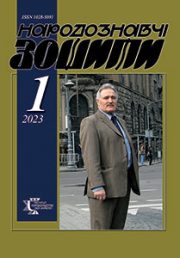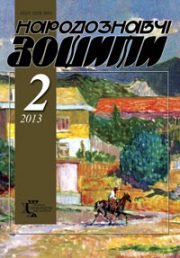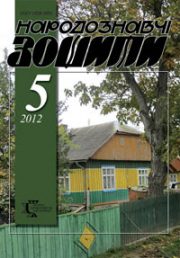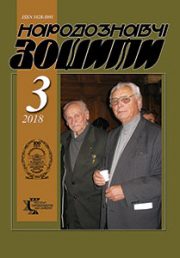The Ethnology Notebooks. 2022. #1 (163). P. 1-264
DOI https://doi.org/10.15407/nz2022.01

Articles
KOZAKEVYCH Olena
MUSEUM OF THE SOCIETY OF «LEMKIVSHCHYNA» IN SANOK: PREREQUISITES FOR ESTABLISHMENT
50—56
PAVLYSHYN Anastasiia
PORTRAITS AND SELF-PORTRAIT AS A SOURCE OF CREATIVE INSPIRATION OF IRENA NOSYK
97—104
LUTSYSHYNA Dariia
THE CREATIVE INTENTIONS OF WOMEN ARTISTS OF THE SQUAT PARCOMMUNE OF THE 1990s
105—112
RADOVYCH Roman
SPECIFIC FEATURES OF ROOFING OF RESIDENTIAL BUILDINGS IN BOIKIVSCHYNA
123—137
KUROCHKIN Oleksandr
SHEPHERDS’ «BETHLEHEM» GAMES OF UKRAINIANS IN TRANSCARPATHIA
176—182
VAKHNIANYN Anna
SECOND WORLD CONGRESS FREE UKRAINIANS: PREPARATION, CONDUCT AND SIGNIFICANCE
192—201
SYPKO Bogdana
FORMATION OF THE AFGHAN COMMUNITY IN FRANCE AT THE TURN OF THE XX—XXI CENTURIES
202—217
HERUS Lyudmyla
CULTURAL AND ARTISTIC SPACE OF «HOLIDAY OF BREAD» FESTIVAL: CONCEPT, FUNCTIONS
218—225
YATSIV Roman
HISTORY OF UKRAINE IN NAMES: SCULPTURAL IMAGES OF YAROSLAV SKAKUN
226—235
HORBAL Маrіa
FINAL CYCLE OF CHRISTMAS HOLIDAYS IN LEMKIVSHCHYNA
236—242
Information







